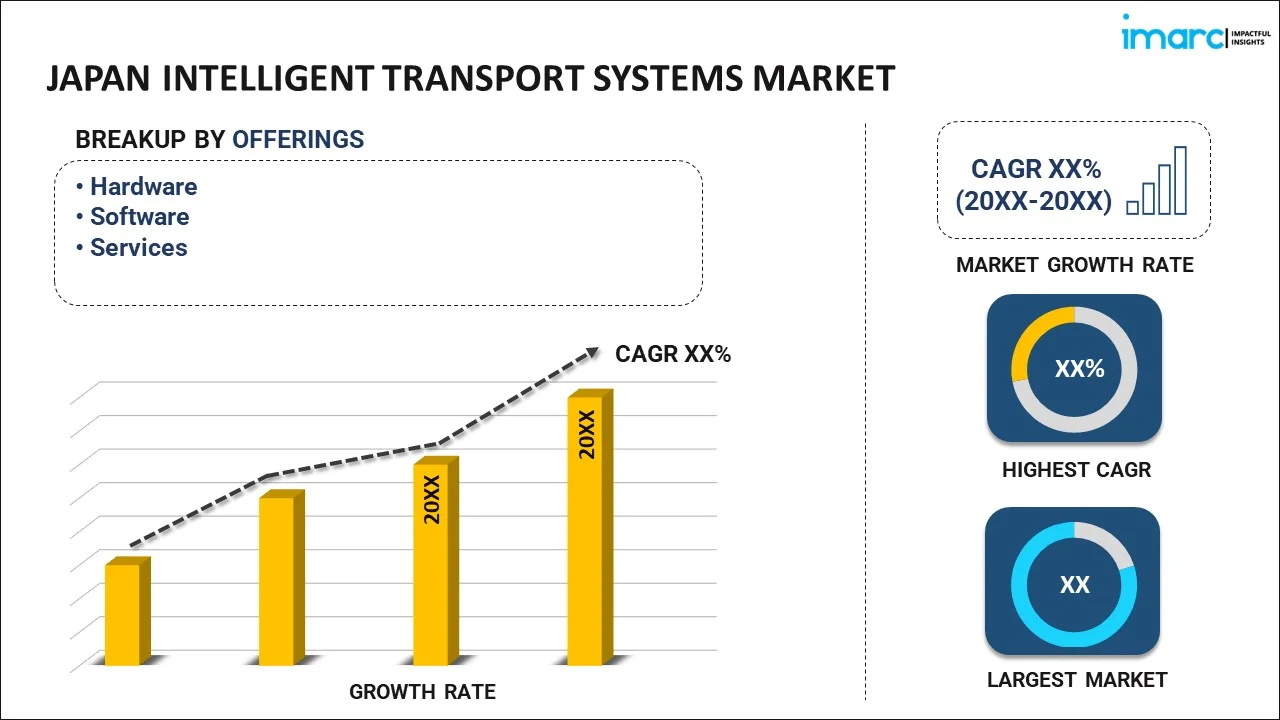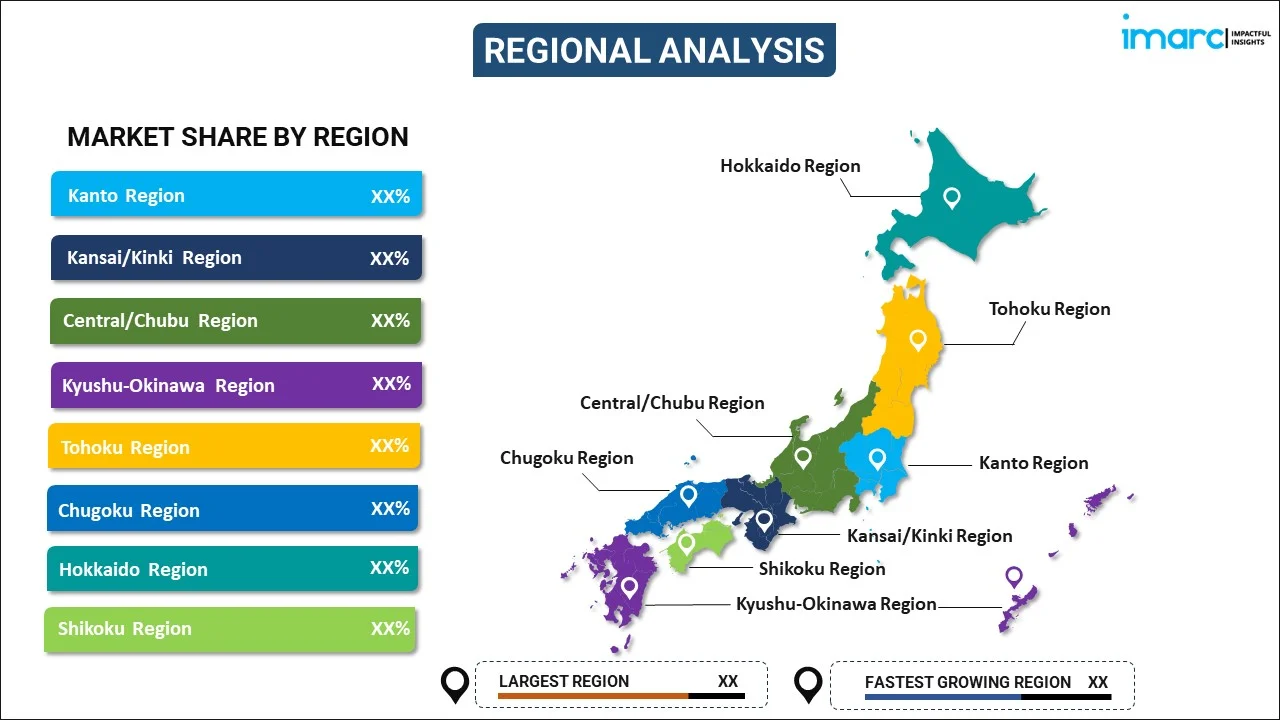
Japan Intelligent Transport Systems Market Report by Offering (Hardware, Software, Services), Product (Network Management Systems, Freight and Commercial Systems, Public Transport Systems, Security and Crime Reduction Systems, Automotive and Infotainment Systems, Road Safety Systems, Communications Systems), Protocol (Short Range, Long Range, IEEE 1512, Traffic Management Data Dictionary (TMDD), and Others), Mode of Transport (Roadways, Railways, Airways), Application (Fleet Management and Asset Monitoring, Intelligent Traffic Control, Collision Avoidance, Parking Management, Passenger Information Management, Ticketing Management, Emergency Vehicle Notification, Automotive Telematics), and Region 2025-2033
Market Overview:
Japan intelligent transport systems market size reached USD 2,917 Million in 2024. Looking forward, IMARC Group expects the market to reach USD 7,239 Million by 2033, exhibiting a growth rate (CAGR) of 10.60% during 2025-2033. The development and integration of autonomous vehicles into transportation networks, coupled with the escalating need for advanced intelligent transport infrastructure, including V2V and vehicle-to-infrastructure (V2I) communication systems, is driving the market.
|
Report Attribute
|
Key Statistics
|
|---|---|
|
Base Year
|
2024 |
|
Forecast Years
|
2025-2033 |
|
Historical Years
|
2019-2024
|
| Market Size in 2024 | USD 2,917 Million |
| Market Forecast in 2033 | USD 7,239 Million |
| Market Growth Rate (2025-2033) | 10.60% |
Intelligent transport systems (ITS) represent a technological revolution in the field of transportation. ITS encompasses a wide range of innovative technologies and applications designed to enhance the efficiency, safety, and sustainability of transportation networks. These systems leverage cutting-edge advancements such as sensors, data analytics, and communication networks to improve traffic management, reduce congestion, and enhance the overall transportation experience. Key components of ITS include real-time traffic monitoring, adaptive traffic signal control, GPS navigation systems, and connected vehicle technologies. These elements work together to optimize traffic flow, minimize travel times, and reduce carbon emissions. Additionally, ITS plays a vital role in promoting road safety through features like collision avoidance systems and automated vehicle control. By integrating information and communication technologies into transportation infrastructure, ITS aims to create smarter, more responsive transportation systems that benefit both individuals and society as a whole.
Japan Intelligent Transport Systems Market Trends:
The intelligent transport systems market in Japan is experiencing robust growth, primarily due to a confluence of factors. Firstly, rapid urbanization is fostering increased demand for efficient transportation solutions, necessitating the implementation of advanced ITS technologies. Furthermore, the pressing need to alleviate traffic congestion and reduce greenhouse gas emissions has accelerated the adoption of ITS. Additionally, government initiatives and funding for smart city development are driving the expansion of ITS infrastructure. Moreover, the proliferation of smartphones and connected vehicles has enabled the seamless integration of ITS services, making them more accessible to the general public. This interconnectedness, along with the growing awareness of the benefits of ITS, is serving as a catalyst for market expansion. Furthermore, the rising focus on safety and the reduction of accidents on roadways is propelling the adoption of intelligent transportation systems, including collision avoidance systems and automated traffic management. In conclusion, the ITS market in Japan is being propelled forward by urbanization, traffic congestion mitigation efforts, government support, technological advancements, and an increased emphasis on road safety. These interconnected drivers are shaping the future of transportation, making ITS an integral component of modern mobility solutions.
Japan Intelligent Transport Systems Market Segmentation:
IMARC Group provides an analysis of the key trends in each segment of the market, along with forecasts at the country level for 2025-2033. Our report has categorized the market based on offering, product, protocol, mode of transport, and application.
Offering Insights:

- Hardware
- Interface Board
- Sensor
- Surveillance Camera
- Telecommunication Network
- Monitoring and Detection System
- Others
- Software
- Visualization Software
- Video Detection Management Software
- Transit Management System
- Others
- Services
- Business and Cloud Services
- Support and Maintenance Services
The report has provided a detailed breakup and analysis of the market based on the offering. This includes hardware (interface board, sensor, surveillance camera, telecommunication network, monitoring and detection system, and others), software (visualization software, video detection management software, transit management system, and others), and services (business and cloud services and support and maintenance services).
Product Insights:
- Network Management Systems
- Advanced Traffic Management Systems (ATMS)
- Road User Charging, Congestion Charging, etc.
- Freight and Commercial Systems
- Public Transport Systems
- Security and Crime Reduction Systems
- Automotive and Infotainment Systems
- Road Safety Systems
- Communications Systems
A detailed breakup and analysis of the market based on the product have also been provided in the report. This includes network management systems (advanced traffic management systems (ATMS) and road user charging, congestion charging, etc.), freight and commercial systems, public transport systems, security and crime reduction systems, automotive and infotainment systems, road safety systems, and communications systems.
Protocol Insights:
- Short Range
- Wave (IEEE 802.11)
- Wpan (IEEE 802.15)
- Long Range
- Wimax (IEEE 802.11)
- Ofdm
- IEEE 1512
- Traffic Management Data Dictionary (TMDD)
- Others
The report has provided a detailed breakup and analysis of the market based on the protocol. This includes short range (wave (IEEE 802.11) and wpan (IEEE 802.15), long range (wimax (IEEE 802.11) and ofdm), IEEE 1512, traffic management data dictionary (TMDD), and others.
Mode of Transport Insights:
- Roadways
- Railways
- Airways
A detailed breakup and analysis of the market based on the mode of transport have also been provided in the report. This includes roadways, railways, and airways.
Application Insights:
- Fleet Management and Asset Monitoring
- Intelligent Traffic Control
- Collision Avoidance
- Parking Management
- Passenger Information Management
- Ticketing Management
- Emergency Vehicle Notification
- Automotive Telematics
The report has provided a detailed breakup and analysis of the market based on the application. This includes fleet management and asset monitoring, intelligent traffic control, collision avoidance, parking management, passenger information management, ticketing management, emergency vehicle notification, and automotive telematics.
Regional Insights:

- Kanto Region
- Kansai/Kinki Region
- Central/ Chubu Region
- Kyushu-Okinawa Region
- Tohoku Region
- Chugoku Region
- Hokkaido Region
- Shikoku Region
The report has also provided a comprehensive analysis of all the major regional markets, which include Kanto Region, Kansai/Kinki Region, Central/ Chubu Region, Kyushu-Okinawa Region, Tohoku Region, Chugoku Region, Hokkaido Region, and Shikoku Region.
Competitive Landscape:
The market research report has also provided a comprehensive analysis of the competitive landscape. Competitive analysis such as market structure, key player positioning, top winning strategies, competitive dashboard, and company evaluation quadrant has been covered in the report. Also, detailed profiles of all major companies have been provided.
Japan Intelligent Transport Systems Market Report Coverage:
| Report Features | Details |
|---|---|
| Base Year of the Analysis | 2024 |
| Historical Period | 2019-2024 |
| Forecast Period | 2025-2033 |
| Units | Million USD |
| Scope of the Report | Exploration of Historical and Forecast Trends, Industry Catalysts and Challenges, Segment-Wise Historical and Predictive Market Assessment:
|
| Offerings Covered |
|
| Products Covered |
|
| Protocols Covered |
|
| Mode of Transports Covered | Roadways, Railways, Airways |
| Applications Covered | Fleet Management and Asset Monitoring, Intelligent Traffic Control, Collision Avoidance, Parking Management, Passenger Information Management, Ticketing Management, Emergency Vehicle Notification, Automotive Telematics |
| Regions Covered | Kanto Region, Kansai/Kinki Region, Central/ Chubu Region, Kyushu-Okinawa Region, Tohoku Region, Chugoku Region, Hokkaido Region, Shikoku Region |
| Customization Scope | 10% Free Customization |
| Post-Sale Analyst Support | 10-12 Weeks |
| Delivery Format | PDF and Excel through Email (We can also provide the editable version of the report in PPT/Word format on special request) |
Key Questions Answered in This Report:
- How has the Japan intelligent transport systems market performed so far and how will it perform in the coming years?
- What has been the impact of COVID-19 on the Japan intelligent transport systems market?
- What is the breakup of the Japan intelligent transport systems market on the basis of offering?
- What is the breakup of the Japan intelligent transport systems market on the basis of product?
- What is the breakup of the Japan intelligent transport systems market on the basis of protocol?
- What is the breakup of the Japan intelligent transport systems market on the basis of mode of transport?
- What is the breakup of the Japan intelligent transport systems market on the basis of application?
- What are the various stages in the value chain of the Japan intelligent transport systems market?
- What are the key driving factors and challenges in the Japan intelligent transport systems?
- What is the structure of the Japan intelligent transport systems market and who are the key players?
- What is the degree of competition in the Japan intelligent transport systems market?
Key Benefits for Stakeholders:
- IMARC’s industry report offers a comprehensive quantitative analysis of various market segments, historical and current market trends, market forecasts, and dynamics of the Japan intelligent transport systems market from 2019-2033.
- The research report provides the latest information on the market drivers, challenges, and opportunities in the Japan intelligent transport systems market.
- Porter's five forces analysis assist stakeholders in assessing the impact of new entrants, competitive rivalry, supplier power, buyer power, and the threat of substitution. It helps stakeholders to analyze the level of competition within the Japan intelligent transport systems industry and its attractiveness.
- Competitive landscape allows stakeholders to understand their competitive environment and provides an insight into the current positions of key players in the market.
Need more help?
- Speak to our experienced analysts for insights on the current market scenarios.
- Include additional segments and countries to customize the report as per your requirement.
- Gain an unparalleled competitive advantage in your domain by understanding how to utilize the report and positively impacting your operations and revenue.
- For further assistance, please connect with our analysts.
 Inquire Before Buying
Inquire Before Buying
 Speak to an Analyst
Speak to an Analyst
 Request Brochure
Request Brochure
 Request Customization
Request Customization




.webp)




.webp)












